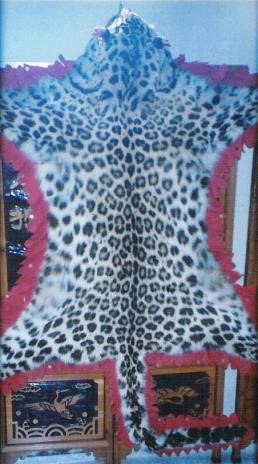
By Jenny Lee WIRED Korea
It was a chilly evening in 1935, when a seemingly wild and untamed animal suddenly appeared before residents of a village in Namwon, North Jeolla Province. Convinced that it was a hungry tiger foraging for food, the residents started spreading the news to their neighbors to be on alert and stay away from the woods.
But one brave man who ran a brewery in town stepped forward, charging and knocking down the beast with help from several hunters and hunting dogs. As it turned out, this animal taken down by Choi Dong-sik was a leopard – and it is now the only leopard left in South Korea.
It was the hide of this large carnivore that was used to prove that Korean leopards shared the same lineage as Amur leopards (Panthera pardus orientalis), a species subordinate to the leopards found in the Russian Far East and parts of northeastern China.
Although this classification has been proposed many times based on their geographical distribution and form and widely accepted, a recent study conducted by Lee Hang, a professor at

“Though much research has been done on leopard population genetics, whether the leopards that inhabited South Korea were of the same subspecies as the Amur leopard population could not be confirmed due to the absence of genetic specimens,” says Lee, who also heads the Korea Tiger and Leopard Conservation Fund. “There are virtually no remains left of Korean leopards from which genetic specimens could be extracted.”
Historical records show that leopards were abundant throughout the Korean peninsula during the Joseon Dynasty era, which lasted from 1392 to 1910. But the leopard population declined rapidly to the point of extinction during the Japanese colonial rule of the peninsula from 1910 to 1945 and the following decades owing to indiscriminate poaching and loss of habitat. Although informal eyewitness accounts of leopards had persisted until the 2000s, the last official record of a leopard captured and photographed in Korea was in the 1970s. It was Choi’s.
Lee and his teammates, who have been studying leopards for more than a decade, acquired the leopard’s hide in 2014, the beautiful skin rug which had decorated Choi’s home until 1999. Genetic samples were then collected from various parts of the leopard specimen, including the footpad, claw, ear and nose.
Lee says extracting DNA from old skins is difficult because they have mostly been treated with chemicals for long-term storage.
“We could not extract DNA samples from the fur itself, but we were able to obtain samples from the cartilage under the claws attached to the leather,” Lee says.
The leopards’ nucleotide sequences were then determined and juxtaposed with those of nine leopard subspecies from the GenBank repository of the United States. The results were that the South Korean leopard showed the highest genetic similarity with Amur leopards from North Korea and Russia.
Lee says the results of this research are consistent with what was expected, but they are meaningful in that they indicate reintroducing the species back to the Korean peninsula is now a real possibility. Amur leopards are still roaming free in an area straddling Russia, China and North Korea, though their numbers are scarce, with fewer than 100 Amur leopards remaining.
There are two possible directions for the restoration, he says.
One is through the natural dispersal of leopards into North Korean territory, where nature is well preserved. But this requires cooperation from North Korean authorities.
The other is the reintroduction of captive-bred Amur leopard individuals into the South Korean region such as the Korea demilitarized zone (DMZ), which consists of high mountains and dense temperate forests, which are important habitats for wildlife. At DMZ, there is a low human population density and high density of prey animals such as ungulates.
“Restoring the top predators in the ecosystem is important in terms of preventing infectious diseases such as the novel coronavirus,” Lee says. “They can help restore the balance of the ecosystem that humans have single-handedly destroyed by reducing the chance of human-wild animal interaction.”
저작권자 © WIRED Korea 무단전재 및 재배포 금지
이 기사를 공유합니다


 뉴스레터 신청
뉴스레터 신청